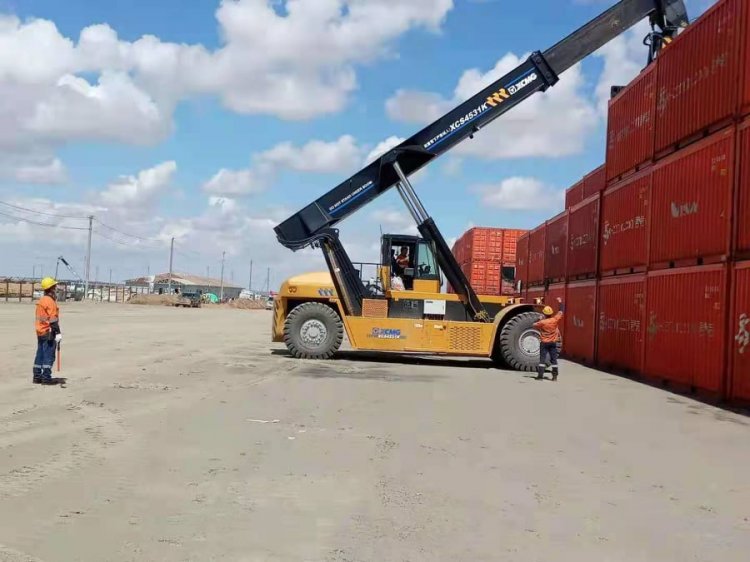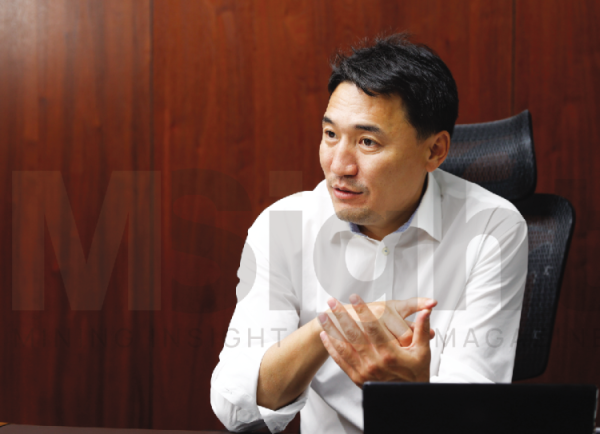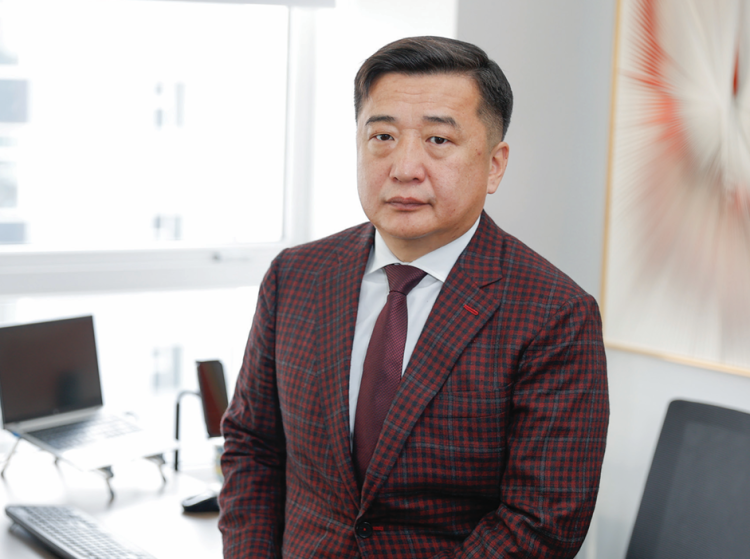 Mining Insight’s Bulgan.B spoke with G.Battsengel, Executive Director of Energy Resources LLC, regarding Mongolia’s mining sector prospects, Gashuunsukhait checkpoint, infrastructure, and coal exports.
Mining Insight’s Bulgan.B spoke with G.Battsengel, Executive Director of Energy Resources LLC, regarding Mongolia’s mining sector prospects, Gashuunsukhait checkpoint, infrastructure, and coal exports. First off, how is the situation at the Gashuunsukhait border checkpoint?
Over 50 percent of Mongolia’s exports go through Gashuunsukhait. On top of Oyu Tolgoi’s copper concentrates, “Erdenes Tavan Tolgoi”, “Energy Resources”, and “Tavan Tolgoi” export coal on this route. Despite being so crucial, the infrastructure at the checkpoint is outdated and lacks investment and development. In cooperation with “Erdenes Mongol”, we constructed the current infrastructure at total financing of over MNT 10 billion, of which “Energy Resources” covered the majority, in 2012. It has been over a decade and we have not seen any renovation since then, unfortunately. The Chinese Government’s CNY 1 billion non-refundable aid has been allocated for the Zamyn-Uud-Gashuunsukhait border checkpoint to expand bilateral trade. It seems the renovation and expansion of the port were delayed due to the pandemic in 2020. There is even a unit called “Development Guide” that is in charge of the renovation and the necessary financing and designs are already in place for them. In 2021, a container transport terminal was established under public-private partnership frameworks. The government and state institutions acted promptly. “Energy Resources” dispensed over MNT 40 billion from its funds in advance for the common interests of Mongolia and committed to it. The use of the container terminal is now improving. Previously, the driver passed the PCR test and entered the border once a day, but now the cars leaving the terminal return twice a day. Productivity improved and coal exports began to rise. This is a real example of how the work goes faster with a public and private partnership in construction.
The initial plans of the Tavantolgoi-Gashuunsukhait railway project were also through such partnerships. After over a decade, it is now underway with the cooperation of the state and a private company. Do you think the expectation of this railway remains the same today?
The Tavantolgoi-Gashuunsuhait is a key route as an export railway connecting with the target market. It seems that the point of connecting the railway across the border of the two countries was agreed upon by both sides during the official visits of the Mongolian Prime Minister to China and the Chinese Foreign Minister Wang Yi to Mongolia. The construction of a 230 km-long railway from the mine to the port has been completed. Since the 20 km railway of the border port has been ratified, the business solution is only a matter of time. The construction of the cross-border facility will take at least 1-2 years. By connecting with the Chinese railway network, Mongolia’s export products will reach the target market more efficiently at a low cost. It was only in 2014 that a solution was put forward to bring the railway from the border to the mine. Erdenes Tavan Tolgoi, Energy Resources, and Tavantolgoi formed a joint venture with Shenhua Group, the owner of the Chinese Gantsmod Port Railway, and went to implement the Gashuunsukhait railway project. It was also supported by the government. The Mongolian side will own 51 percent of the joint venture, and the Chinese “Shenhua Group” will hold 49 percent as part of a concession deal. Everyone remembers that there were negotiations on transferring the railway management to Mongolian Railway SOE once the sides recovered their investment, however, the negotiation came to a deadlock for some reason. During the pandemic, Mongolians had first-hand experience with the downstream impact of bottlenecks at the border. The key purpose of railway transportation is to transport goods abroad. Domestic transportation is something the government can regulate and private companies can adjust to. However, cross-border transportation is, to a certain extent, highly dependent on another country.
“Erdenes Tavantolgoi” is aiming to increase coal exports to 45-50 million tonnes. The Tavantolgoi-Gashuunsukhait railway is planned to have a capacity of 30 million tonnes. What will be the export potential of other companies operating in the Tavantolgoi residual deposits?
The road infrastructure in Gashuunsukhait that we’re currently using has a capacity of transporting 20 million tonnes and next to it, there is a railway with a capacity of 30 million tonnes. On top of that, there is a Tavantolgoi-Zuunbayan route rail with a 15 million tonnes capacity. Another railroad is under construction from there to Khangi border checkpoint and it will also have a 15 million tonnes capacity. There is an existing route to Zamyn-Uud port owned by Ulaanbaatar RailwayJV. The amount of coal exported from the Tavantolgoi group of deposits alone will be 65 million tonnes, which is a significant increase from the current level. We also can’t overlook the development of road infrastructure. The upcoming Baruunnaran-Tsagaandel Uul route road will carry a total of 10 million tonnes. It will take 2-3 years for the infrastructure to be operational, the railways to be connected across the border, and the transport operations to be smoothed out if it is not hampered by politicization and local resistance. Therefore, depending on the development of the infrastructure, it is estimated that the coal export of our country will increase almost 2-3 times. This will also make room for thermal coal exports. The Government is prioritizing the development of border checkpoints and infrastructure through its “New Recovery” policy. If the railroad is constructed without any political interest, it will bear its fruit for the country and its people.
 Will “Energy Resources” increase its coal exports in line with the newly commissioned infrastructure?
Will “Energy Resources” increase its coal exports in line with the newly commissioned infrastructure?“Energy Resources” exported a total of 6 million tonnes at its peak. The feasibility study estimated the capacity at over 10 million tonnes from Ukhaakhudag and 12 million tonnes from the Baruun Naran mine. So basically, we can double our coal exports if the infrastructure is well set up. The Ukhaakhudag concentrator has a capacity of 15 million tonnes, however, the highest washing output was 10 million tonnes of coal so far.
Not only “Energy Resources”, companies operating at Tavan Tolgoi residual deposits, namely “Erdenes Tavantolgoi” and “Tavantolgoi” have enough room to boost their exports.
How many tonnes of coal is expected by the “Energy Resources”, which supplies products to Baotou steel producers and coal consumers, on the Zuunbayan-Khangi rail route?
Depends on the buyer’s location. Transportation via the Zuunbayan-Khangi railway could be shorter. Some may even want to take it through Gashuunsukhait port.
In the current geopolitical situation, it seems that there is an increased demand for Mongolian coal in some countries. Is that true?
The European Union announced (August 20, 2022) that it has stopped buying coal from Russia. On the other hand, the demand for thermal coal in Europe is rising due to the heightened price of gas. Australia and South Africa will increase their supply of thermal coal to Europe by stopping imports from Russia. However, because there is a shortage, the issue of buying thermal coal from Mongolia, Kyrgyzstan, and Kazakh stan is under discussion. In general, the interest and demand for Mongolian thermal coal have surged. A sudden shock in our coal market is likely due to the sharp rise in gas prices, fluctuating supply, and incoming winter. But I can’t predict how long it will last.
Is it an opportunity for our country, which has a lot of thermal coal reserves, to increase its exports?
Regarding this winter, there is an opportunity for Mongolian thermal coal. It is difficult to say whether it will be a stable demand in the future or a short-term opportunity stemming from the war. Foreign affairs do not depend on us Mongolians. But it is an opportunity in our country.
Let’s say we try and make use of this opportunity, will it be difficult to transport through the neighboring countries? Is it difficult to include Mongolian coal in China’s domestic railway network?
Mongolian companies cannot provide rail transportation. A negotiation with Russian and Chinese railway transport companies is necessary. This is something we need to consider at the government level. We can transport through Russia. But shippers probably won’t dock at Russian ports due to the geopolitical tension. Even if they did, there is a risk that freighters may not be able to unload at the final destination because of the ban. Mongolia still hasn’t resolved the transit transportation issues with China. Sides signed a transit declaration in 2014 during the visit of Chinese President Xi Jinping to Mongolia. But the contract was abandoned. Under the current agreement, it is not possible to transit through China. There are joint ventures in China for rail transport logistics and sales. For example, we have a sales venture where we own a 51 percent stake. It was established to handle the transport logistics on the Chinese side. It is a Mongolian-invested company registered in China.
At a time when the price of coking coal is at a historic high, is “Energy Resources” considering supplying its coal to the third market?
We tried exporting our coal to Taiwan, India, and Japan in 2012. The main problem is the cost of infrastructure and transportation. Although the infrastructure projects are moving forward, they are not fully resolved yet. Maybe after 1-2 years when the infrastructures are in place, the actual cost of transportation may make it feasible, but it will depend on the market trend at that time.
Coal producers made huge profits thanks to rising prices and demand in the global market. Did Mongolian companies have a chance to boost their profits, at least a little bit?
There was no such opportunity because of the situation at the port and lack of infrastructure.
Mongolia’s key competitor in the coal industry Russia has increased its supply to China. How do you see it affecting your sales?
Statistics show that Russia’s coal exports skyrocketed over the last few years. The country used to export 20-30 million tonnes of coal. It is now at around 150 million tonnes, and the country has set a goal to surpass 200 million tonnes in the future. In the current geopolitical situation, Russia will seek to shift its European embargoed coal trade to the Asian market. Japan and South Korea are unlikely to import Russian coal. So the big target market will be India and, of course, China.
China’s economic growth has slowed sharply. Due to a housing crisis, steel production is expected to decline. Do you see any risk affecting Mongolia’s coking coal exports?
There is always a risk. One of the characteristics of the Chinese market is the high level of government involvement. The country has enough capacity to maintain a healthy economy. Even now, there is an expectation that the Chinese Government may turn to policies aimed at stabilizing its economy. Mining giants are also warning about this in their reports. If you look at the bigger picture, the main consumers of Chinese steel are the infrastructure and construction industries, such as railways and bridges, as well as the manufacturing of machinery, equipment, and parts. In the first half of the year, steel consumption in China’s construction industry fell, however, production of equipment rose. The Chinese government will not allow economic “free fall” and there will be policy support. From this point of view, the risk is relatively low.
Does the “Energy Resources” have any longterm goals to diversify its production with other minerals?
The 2015 collapse of the commodity market showed us the risk of depending on a single mineral. As a private company, we want to expand our operations. The majority of Mongolia’s exports comprise coal, copper concentrate, iron ore, gold, and oil. Our company has no experience in the oil sector. Iron ore is also dependent on steel production, so it is no differ ent from coal. Prices of both coal and iron ore fall when the steel industry is challenged. As for gold, our country is running out of alluvial deposits. Large-scale projects of deep mines and placer deposits, which require more technical equipment, are in discussion recently. We believe that these types of projects can make real contributions and help expand gold reserves.
Our parent company is a Mongolian Mining Corporation. “Energy Resources” is a subsidiary that specializes in coal, so there may be other companies in gold and copper.
But we had no time to think about expansion in the last few years because of the pandemic. In any case, our company has to further invest in the gold and copper industries. There is no concrete solution yet. We believe that it is the right direction moving forward.
How would you define responsible mining?
Since its inception, “Energy Resources” LLC has been prioritizing the benefits of all parties, including the local community, state, and public in the entirety of its operations and projects. We aim to allocate the benefits of the project to more people via various channels, such as jobs, supplies, taxes, etc. We focus on supporting individuals and enterprises manufacturing and supplying products to our company, empowering national producers, creating quality jobs, and providing a source of income. Of course, it is important to ensure that our activities do not impact the environment. Generally speaking, all business activities affect the environment to some degree. Traditional animal husbandry in our country has the most negative impact on the environment. The focus is on how to minimize and neutralize the impact. This is how “Energy Resources” LLC has been working since its establishment. Simply put, responsible mining is to “not take ethics lightly”. Reputation is crucial for companies carrying out large new projects that will stimulate the development and economy of Mongolia. To create a good story, one must work with proper plans. This is our view of responsible mining. Any business, not just mining, is based on responsibility. It is important to make an actual contribution and be effective, instead of suddenly popping up for a “donation”.
Mining companies around the world are giving special attention to ESG. Is “Energy Resources” taking ESG measures?
The ESG standards became a hot topic only recently in Mongolia. Energy Resources adopted those standards in its operations 3-4 years ago. We are almost the first company in Mongolia to voluntarily report under the ESG standards. We’ve been receiving professional services from independent agencies for ESG review in recent years.
You have recently been elected as the Chairman of the Council of Mongolian National Mining Association (MNMA). What is your primary focus as its chair?
In terms of governance, I see it as my duty to provide the Board of Directors with opportunities, organize its activities, and ensure its integrity. The main goal is that the new generation of young people working in the mining industry of Mongolia will come forward to lead and grow. MNMA elected a young CEO recently. We see more young people in the activities of the board. They represent the new generation of the Mongolian mining industry. Therefore, I will support it in every way. Any industry has succession. There is a time for everything. Young people see some things as better and are more courageous than us. The experience of our generation, the different perspectives, and the skills of young people should be combined. This will push Mongolia’s mining industry to a new stage.
Numerous factors drag down the development of Mongolia’s mineral resources sector. What do you think is the most difficult issue at the moment?
The 2010 frenzy. Politicians, the public, people in our industry, and the media are all fooling themselves as if the world will collapse if Mongolia does not produce its copper, coal, and minerals. Therefore, MNMA is preparing reports to show the reality of the situation. Frankly speaking, Mongolia is “tiny” in the global stage of mining. Today, Mongolia is not even among the top 15 in the world in terms of copper production. Our main coal market is China, which produces 4 billion tonnes domestically and has abundant reserves. Australia is the leading producer of iron ore. We need to make down-to-earth decisions and see the country’s economic potential, resources, and production capacity realistically and comparative to other countries. By understanding where we stand, we can identify our problems and clear out a development path. We do not have much choice. At present, mining is the only sector that can attract foreign investment and draw in foreign exchanges. Improving the competitiveness of the mining industry requires a lot of support from all sides, starting with the public. It will be the main goal of MNMA to make all stakeholders understand that the country will develop and move forward if the government, public, industry players, and companies work together. The mining sector accounts for over 70% of foreign direct investment in our country. The investment phase of the Oyu Tolgoi project will be officially completed when the underground mine starts operation next year. After that, the mining sector will no longer create over 70 percent of FDI. Investors won’t rush over here just because we’re declaring to improve the investment environment. Oyu Tolgoi is the result of a special license issued in 1996 when the country passed the Mineral Law. This project has been driving Mongolia’s economy since the beginning of 2000. Tavan Tolgoi, Ukhaakhudag, and railway projects were also important contributors to the economy. The combination of foreign and domestic investment forms the economy. What is the next project that will attract capital to our country in the coming years? After the construction of Oyutolgoi, what will the young people who worked in it do? It is too late if we don’t look for answers to these questions now. The sub-contractors and thousands of employees will be left on the street once the railways are put into operation. Many national companies involved in these development projects are employers and taxpayers of the country. Qualified and experienced personnel is a great advantage from the economic point of view.
Exploratory work should be carried out to prepare for the next projects. Without exploration, new projects will not emerge. If there are no new projects, there will be no economic growth. Mongolia’s economy has been “stuck” at USD 10 billion for a decade.
Explorations drive large projects that will determine the fate of the country in the next 20-30 years. This is the only solution for people to keep their jobs and income. Therefore, it is good to plan and integrate the national economy following the interests of the public.
Mining Insight Magazine July & August 2022



























